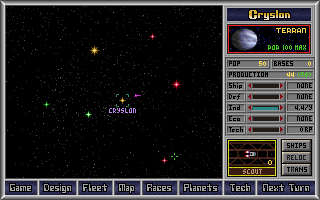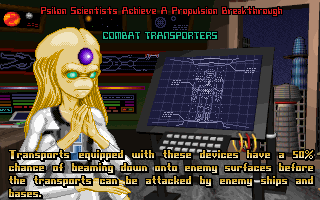4X: Master Of Orion
Feb 21, 2007 · peterb · 7 minute readGames
This is the third in a series of articles about 4X games. Read the introduction here and the previous article here.
Perhaps the most well-known of the early era 4X games was Master of Orion. Master of Orion was developed by Simtex, who engendered a cult following with their overrated game Master of Magic. Orion was published by Microprose in 1993. This meant that it had real marketing muscle–Microprose was one of the giants in its day.
I’m going to talk (briefly) about all three games in the series, which might be a bit unfair, since for the most part the three games have nothing to do with one another. Life is tough sometimes. Let’s start with the first one.
Master of Orion is a very playable game. It can fairly be described as Spaceward Ho With Stuff. But the Stuff it adds is not trivial stuff, and shouldn’t be dismissed out of hand.
 ]
]
The basic mechanics of exploration, shipbuilding, and colonization are similar. Instead of Spaceward Ho’s straightforward “fuel unit” limitation on range, Master of Orion lets you explore any system within so many parsecs of any colonized world, which frees you up from having to micromanage your travel. This is good, because I hates micromanagement. I hates it, I hates it, I hates it forever.
The game brings a lot of color to the genre. Each team in the game is a different species, and each species has certain advantages or disadvantages. For example, the dog-like Bulrathi are more effective at ground combat, while the Psilons are superior at researching new technologies, and the bunny-lizard Sakkra hump a lot breed faster.
As in Ho!, the qualities of a world are unknown to you until you visit, but you can glean a little information from the color of the star. There are no guarantees, but certain star colors are more likely to have habitable or interesting worlds. That adds a nice bit of flavor to the exploration. In addition to suitability for colonization, worlds may provide you with a technology, economic, or other bonus.
You can spend your money in many ways. You can develop the industry on the worlds you have colonized, or their defense, or invest in technology, or build ships, or spend money on espionage. Technology and ship production are both done on a per-planet basis, which makes juggling the money a bit of a chore, comparatively. I tried collecting all of my money into a big pile and jumping into it naked, but it scared my advisors and, to be honest, it sort of chafed.
 ]
]
Technology research is both interesting and ponderous; the research tree branches in several places, and no given species can research all available technologies. Making certain decisions early on can foreclose other options later. When you do succeed in discovering a new technology, you get a very satisfying little splash screen where a species-appropriate scientist looks smug and explains the implications of the new find. Technologies have a somewhat rock-paper-scissors relationship to each other, so it’s entirely possible to spend many centuries chasing a certain technological thread only to find you’ve tied yourself up in knots and spent tons of resources on something useless. That’s not so fun when it happens.
Master of Orion has a much richer diplomatic game than many others. You can trade worlds, money, or technology with other species, once you’ve established diplomatic relations with them. You can bribe other races, which is a satisfyingly effective way to stave off an impending attack. You can also begin spying on them, spending part of your GDP on espionage. Once you have spies in place, you can use them to steal technology, perform sabotage, or engage in counter-espionage activities. A well-placed spy can tip the balance of a close game.
There are a few differences that make Master of Orion a bit easier, strategically. In many 4X games, you need to conquer an enemy world before you can colonize it. In MoO, if you conquer a world with ground troops, the “excess” ground troops become the planet’s native population after the victory. Thus, after the early part of the game you’ll almost never build a colony ship: bomb them from orbit, send in a huge troop transport, and you have a fully-functioning and profitable colony. Worlds can fall like dominoes in this part of the game. Especially if you’re playing as the Bulrathi.
The one part of Master of Orion that doesn’t work is the ship-to-ship combat. It’s a turn-based move-your-mice-roll-your-dice sort of affair that gives the illusion of tactical choice. In reality, there is almost no situation in which the moves you make in tactical combat make any difference whatsoever. In other words, the whole tactical combat screen is nothing more than a humiliating sham that wastes your time. There is an “auto resolve” button where you can have the computer make the moves for both sides. I suggest you press that button the first time you get to the combat screen, and forget that any other option even exists. You’ll like the game more for doing this.
So zooming back up to a high level, I view Master of Orion as a game that lifts most of the good ideas from Spaceward Ho!, and then adds a ton and a half of mise-en-scène to them. The game is an unqualified success, and is probably more attractive to those who seek this sort of game for the setting more than the game itself. If the play is a little less crisp than its immediate predecessor, we can forgive it because it has so much style.
 ]
]
Hoping to capitalize on the name, Simtex released Master of Orion II: Battle at Antares in 1996. A much weaker game, MoO2 was, from my perspective, an attempt to graft the MoO mise-en-scène onto their earlier game, Master of Magic. The city-building parts of that earlier effort were shoehorned into MoO2, and it works about as well as putting a sausage inside a piece of strawberry shortcake: you might want to eat both of them, but, for the love of God, not at the same time.
The reason this doesn’t work, I think, is that there’s a fundamental difference in scope, conceptually, between running a feudal serfdom and a galactic empire. At some point, after the eighth time you’ve told some new planet to build some farms or, y’know, goddamned houses for their citizens, it stops being fun and starts being irritating. “Why am I doing this?” you wonder. “Why am I doing this for these idiots? They don’t deserve my leadership. I should just let them starve to death. Schmucks.” In fairness, there is a “governor” option, but as in most cases, it doesn’t work for me: once the game asks me to make the decision, it has asked me to care. And I can never get those neurons back.
In 2003, Infogrames published Master of Orion 3, a game so stunningly bad that it’s not even worth playing for free. I won’t go into detail here because it’s too depressing to write about. I just wanted to confirm, publically, that it really is about as bad as you heard it was. It’s actually worse. The word “unplayable” doesn’t even come close to describing it: it’s the worst game I’ve played that didn’t actually cause my computer to explode.
The original Master of Orion is clearly the best of the three: it’s fun to
learn, pretty to look at, and if you don’t get bogged down in the pointless
tactical combat, quick moving. It can even still be [bought new at Amazon.](ht
tp://www.amazon.com/gp/redirect.html?ie=UTF8&location=http%3A%2F%2Fwww.amazon.
com%2FMaster-of-Orion-I-DOS%2Fdp%2FB0007AD1HC%2Fsr%3D8-3%2Fqid%3D1172110057%3F
ie%3DUTF8%26s%3Dvideogames&tag=theusualsuspepat&linkCode=ur2&camp=1789&creativ
e=9325)
The next article in this series is about Stardock’s Galactic Civilizations II.